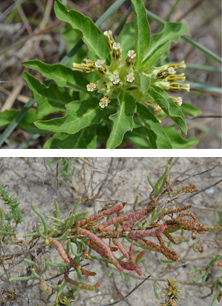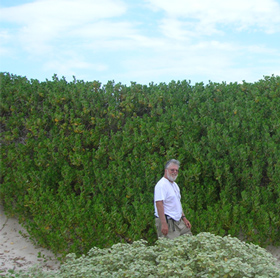In The Line of Fire
WHEN THE NATIONAL PARK SERVICE ASKED WILDFLOWER CENTER STAFF to evaluate vegetation inhabiting Padre Island National Seashore, little did they know of the extreme challenges this survey would entail.
Plant identification experts from the Center spent much of their week roughing it in a crowded fifth-wheel camper with survey leader Arnie Peterson, the Vegetation Mapping Coordinator for NPS’ Gulf Coast Network of parks. Senior Botanist Damon Waitt and two other staff did so to help conduct the most extensive sampling of park vegetation in recent decades – despite 90-plus degree temperatures and swarming mosquitoes.
In addition to the cozy living arrangements while surveying plants along 62 miles of the island, the team and NPS park staff that assisted daily faced challenges such as a wildfire burning on nearly 13,000 acres. Wildfires are a natural part of maintaining habitat on the once barren island, but the fire started by a lightning strike was an unexpected “companion” for three days.
“The crew was out doing surveys while constantly getting radio communication that Monday morning to move out of an area because the fires were headed that way,” said Dr. Waitt. “It was pretty intense for the island to be in flames at the same time we were doing the survey.”
Despite the scorching circumstances that day, Field Botanist Dick Davis and Plant Conservationist Minnette Marr persevered with the help of NPS staff to collect vital data for maintaining and preserving the island’s vegetation.

Among the unusual plants that Minnette Marr and other staff came across during the survey were Zizotes milkweed (top), which Monarch butterfly larvae and other insects favor, and Virginia glasswort, a salt-tolerant member of the Salicornia genus. PHOTO Damon Waitt
“Getting a clean picture of what’s out there is the first step to managing and conserving those lands,” said Waitt.
Accordingly, the team conducted an inventory of the island’s different vegetation on 91 land plots chosen by Peterson. Wildflower Center staff also taught Padre Island staff to improve their skills at identifying the park’s plants and plant communities, and may set the stage for a larger plant community survey next year.
“The surveys are pretty rigorous,” said Waitt. “You not only have to know the vegetation of the park, but you also survey ecological variables. You try to connect the vegetation to the environmental factors to determine the different community and ecosystem types in the area.”
Some of the unique plant communities on Padre Island, which is off the coast of South Texas, were sand dunes and salt flats. In both ecosystems, survey staff found a number of plants adapted to high salt environments – many like Salicornia, which can rid itself of the ocean’s salinity.
Marr, who helped the NPS survey Big Bend last summer alongside Davis and other Wildflower Center staff, found the plant variation during the Center’s third survey interesting.
“The number of grasses, sedges and plants adapted to salt made this survey unique,” she said. “A change in elevation of inches determines whether salt-tolerant species are present.”

Dick Davis, field botanist at the Wildflower Center, stands in front of an extensive beach berry shrub, which likely grew from a single seed that reached Padre Island. PHOTO Kristie Jenkin
Davis echoed her remarks. “One plant observed in the park may well be the rarest in Texas,” he said, referring to beach berry, which occasionally drifts to new locations across the ocean and lacks an established Texas population. “Seeing this attractive and interesting new species was a trip highlight.”
Vegetation surveys can also inform Park Service personnel and land managers how to best manage land in regards to protecting unique plant communities or removing non-native, aggressively growing plants. During the survey, Marr and her colleagues found an invasive plant, Australian pine, growing in close proximity to several stands of a long-established invasive plant, Brazilian pepper tree.
“If there is an invasive plant that just shouldn’t be on the island, it’s very likely we would notice it,” Marr said. “It will never be easier for NPS to control the Australian pine than right now.”
The Wildflower Center will also help NPS conduct vegetation surveys of Amistad National Recreation Area just west of Del Rio, Texas, and of the Rio Grande Wild & Scenic River. Marr believes vegetation surveys like these help fulfill the Center’s mission once set by Lady Bird Johnson.
“I think this type of work is a good fit for the Wildflower Center,” said Marr. “We can go in and provide some expertise that the park service possibly doesn’t have. I think Mrs. Johnson would really appreciate that.”
Written by Matthew Leach

